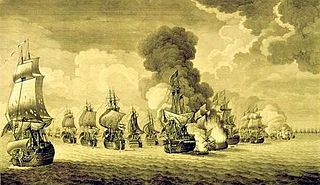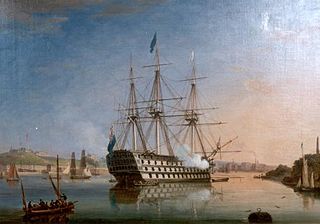 W
WAmerica was a 60-gun ship of the line of the Spanish Navy, launched in 1736.
 W
WThe Spanish ship Argonauta was a third-rate 80 gun ship of the line of the Spanish Navy. She had 24, 18 and 8 pounder guns spread over two decks. Her usual crew was 642, though it was 956 at the Battle of Cape Finisterre and 800 at Trafalgar.
 W
WBahama was a 74-gun ship of the line of the Spanish Navy. She was built in Havana on plans originally drawn by Ignacio Mullan for the 64-gun San Pedro de Alcantara, completed as a project of Gautier. She was later rebuilt as a 74-gun.
 W
WFénix was an 80-gun ship of the line (navio) of the Spanish Navy, built by Pedro de Torres at Havana in accordance with the system laid down by Antonio Gaztaneta launched in 1749. In 1759, she was sent to bring the new king, Carlos III, from Naples to Barcelona. When Spain entered the American Revolutionary War in June 1779, Fénix set sail for the English Channel where she was to join a Franco-Spanish fleet of more than 60 ships of the line under Lieutenant General Luis de Córdova y Córdova. The Armada of 1779 was an invasion force of 40,000 troops with orders to capture the British naval base at Portsmouth.
 W
WNeptuno was an 80-gun Montañes-class ship of the line of the Spanish Navy. She was built in 1795 and took part in the French Revolutionary and Napoleonic Wars. She fought with the Franco-Spanish fleet in the battle of Trafalgar, and was wrecked in its aftermath.
 W
WSantísima Trinidad was a Spanish first-rate ship of the line with 112 guns. This was increased in 1795–96 to 130 guns by closing in the spar deck between the quarterdeck and forecastle, and to 140 guns around 1802, thus creating what was in effect a continuous fourth gundeck although the extra guns added were actually relatively small. She was the heaviest-armed ship in the world when rebuilt, and bore the most guns of any ship of the line outfitted in the Age of Sail.
 W
WHMS Princess was a 70-gun third rate ship of the line of the Royal Navy. She had briefly sailed as Princesa for the Spanish Navy, until her capture off Cape Finisterre in 1740 during the War of the Austrian Succession.
 W
WRayo was an 80-gun ship of the line of the Spanish Navy. As was traditional for Spanish ships not named after a saint, its second, dedicatory name was San Pedro Apóstol. She underwent rebuilding at Cartagena from 1803 to 1805, emerging as a three-decked ship with 100 guns. She then fought at the Battle of Trafalgar during the Napoleonic Wars and was dismasted as a result of damage sustained in the battle. When she sortied after Trafalgar in order to recover prizes, the warship was captured by HMS Donegal. Subsequently, she ran aground and was wrecked in a storm. Her broken hull was set ablaze and destroyed by British sailors on 31 October.
 W
WReal Carlos was a 112-gun three-decker ship of the line built at Havanna for the Spanish Navy in 1787 to plans by Romero Landa. One of the eight very large ships of the line of the Santa Ana class, also known as los Meregildos, Real Carlos served in the Spanish Navy during the French Revolutionary Wars and was destroyed with heavy loss of life during the Second Battle of Algeciras.
 W
WThe Reina Luisa was a 112-gun three-decker ship of the line built at Ferrol for the Spanish Navy in 1791 to plans by José Joaquín Romero Fernández de Landa. One of the eight very large ships of the line of the Santa Ana class, also known as Los Meregildos. The Reina Luisa served in the Spanish Navy for three decades throughout the French Revolutionary and Napoleonic Wars, finally being wrecked off Béjaïa in 1815. Although she was a formidable part of the Spanish battlefleet throughout these conflicts, she did not participate in any major operations.
 W
WSalvador del Mundo was a 112-gun three-decker ship of the line built at Ferrol for the Spanish Navy in 1787 to plans by Romero Landa, one of the eight very large ships of the line of the Santa Ana class, also known as los Meregildos. Salvador del Mundo served during the French Revolutionary Wars until its capture at the Battle of Cape St Vincent by a Royal Navy fleet on 14 February 1797. Salvador del Mundo remained in British hands throughout the Napoleonic Wars, serving as a harbour ship, until it was sold and broken up in 1815.
 W
WThe San Agustín was a 74-gun ship of the line built at the royal shipyard in Guarnizo (Santander) and launched in 1768.
 W
WSan Francisco de Asis was a Spanish 74-gun ship of the line launched in 1767 from the royal shipyard in Guarnizo (Cantabria). She was wrecked after the Battle of Trafalgar in 1805 near Puerto de Santa Maria.
 W
WSan Hermenegildo was a 112-gun three-decker ship of the line built at Havanna for the Spanish Navy in 1789 to plans by Romero Landa, one of the eight very large ships of the line of the Santa Ana class, also known as los Meregildos. San Hermenegildo served in the Spanish Navy during the French Revolutionary Wars and was destroyed with heavy loss of life during the Second Battle of Algeciras.
 W
WSan Ildefonso was a ship of the Spanish Navy launched in 1785. She was designed to be lighter than traditional Spanish vessels which had had difficulty matching the speed of ships of the Royal Navy. Though nominally a 74-gun ship San Ildefonso actually carried 80 cannons and howitzers. She saw service against French and British vessels in the late 18th century, sailed twice to the Americas and was trapped in Cadiz by the British blockade. San Ildefonso was captured by the British third-rate HMS Defence at the Battle of Trafalgar and successfully weathered the storm afterwards to be taken into Royal Navy service as HMS Ildefonso.
 W
WHMS San Josef was a 114-gun first-rate ship of the line of the Royal Navy. Originally built at Ferrol in Galicia for the Spanish Navy in 1782–83, she was captured from the Spanish Navy at the Battle of Cape St Vincent on 14 February 1797. In 1809 she served as the flagship of Admiral John Thomas Duckworth.
 W
WSan Juan Nepomuceno was a Spanish ship of the line launched in 1765 from the royal shipyard in Guarnizo (Cantabria). Like many 18th century Spanish warships she was named after a saint. She was a solidly built ship of proven seaworthy qualities. Captured by the British Royal Navy during the Battle of Trafalgar, the ship was renamed first HMS Berwick, then HMS San Juan. The ship was discarded in 1816.
 W
WSan Nicolás was an 80-gun third-rate ship of the line of the Spanish Navy.
 W
WSanta Ana was a 112-gun three-decker ship of the line of the Spanish Navy, built to plans by Romero Landa. She was the prototype and lead ship of the Santa Ana class, also known as los Meregildos, which were built during the following years at Ferrol and Havana and which formed the backbone of the Spanish Navy - the other ships were the Mejicano, Conde de Regla, Salvador del Mundo, Real Carlos, San Hermenegildo, Reina María Luisa and Príncipe de Asturias. Her dimensions were 213.4 Burgos feet long, 58 feet in the beam and a total tonnage of 2,112 tonnes.